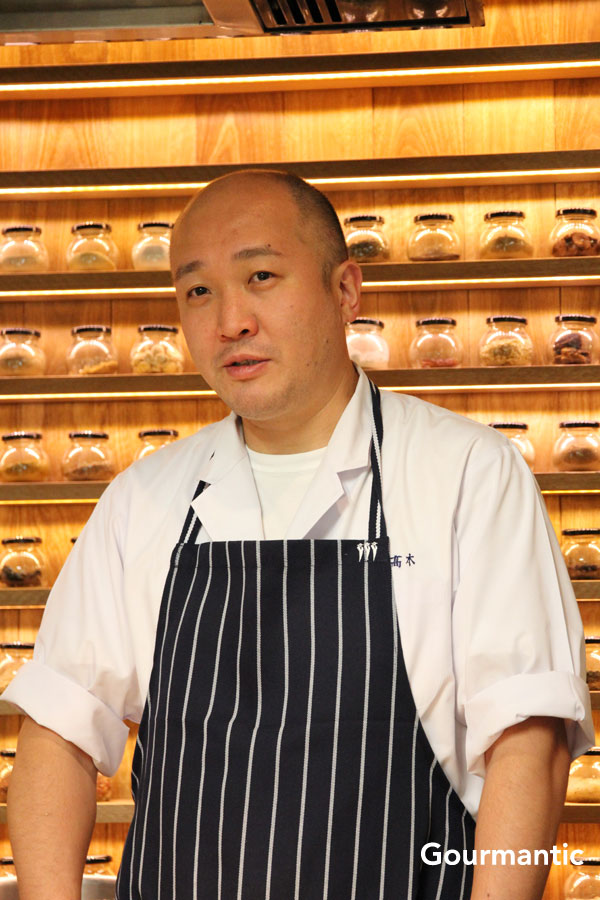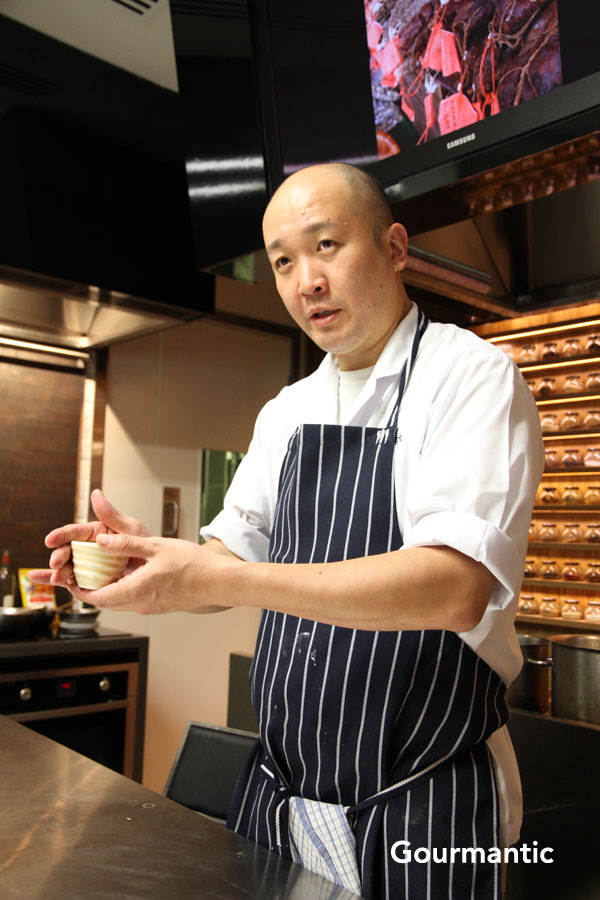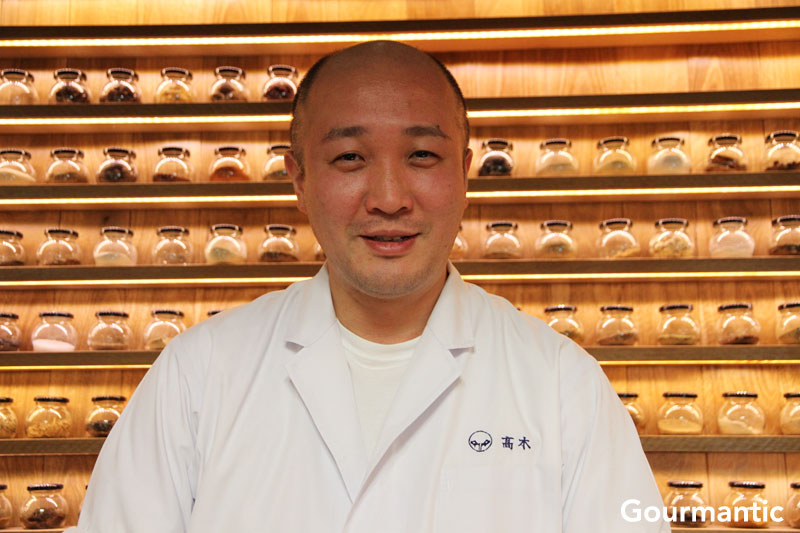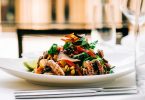 On October 1st, I had the privilege of attending an intimate chef’s table event with Shin Takagi at Quarter Twenty One Cookery School. Shinichiro Takagi is one of Japan’s top young chefs and owner and head chef of Zeniya restaurant in Kanasawa, a highly acclaimed kaiseki, or Japanese haute cuisine restaurant.
On October 1st, I had the privilege of attending an intimate chef’s table event with Shin Takagi at Quarter Twenty One Cookery School. Shinichiro Takagi is one of Japan’s top young chefs and owner and head chef of Zeniya restaurant in Kanasawa, a highly acclaimed kaiseki, or Japanese haute cuisine restaurant.
Shin travels abroad frequently to prepare kaiseki meals and participate in international culinary events. In June 2011, he joined Alain Ducasse, Guy Savoy and other chefs for a charity banquet in Paris to help victims of Japan’s earthquake and tsunami.
During a two-day visit to Sydney, he joined Chef Justin North on a morning tour of the markets before returning to Quarter Twenty One Cookery School to create a menu inspired by the produce. During the course of the evening, he was kind enough to answer candid questions from our group. At the conclusion of the event, I had the opportunity to ask a few questions of my own, which together with those of others, make up this question and answer style interview.
Why did you become a chef?
My father was a well known chef. When he passed away suddenly, I was at university studying marketing. My younger brother was going to culinary school in Osaka. My father’s friend came to the restaurant and asked if I am taking over and be a chef. I said, I don’t know yet. He introduced me to one of Japan’s top restaurants, Kitcho, and arranged an interview to get into restaurant. I couldn’t find a reason not to like it.
How long have you been a chef?
I started after university, I was 23 years old. At 27, I started working in the restaurant. I became head chef at Zeniya at age 32. I am also the youngest head chef in my region but also the oldest in my kitchen. Most head chefs are over 60 years old. I am 41 years old.
Tell me a little about your restaurant Zeniya and the philosophy behind it.
There is no menu at Zeniya. The chef goes to the markets every day and picks seasonal produce. Once you make a reservation, my staff ask you where you come from, what you don’t like to eat, how long you’re staying in Kanasawa, did you go to other restaurants in the area. This kind of information helps me to design the menu. For example, if they’re very tired, I plan a light menu based on how I think they want to eat.
Do your customers like to eat differently?
I make different menus for people from different areas. For example, if they order 15000 yen tasting menu, and they come from Malaysia, they already eat seafood from the Japan Sea. But customers from foreign countries always want to eat fresh seafood from our region.
Do you find many variations in taste among people from different regions?
People from Tokyo are always crazy about crab. Crab season is from 1st week of November to the end February. But they don’t care about the seasons. They want to eat it.
What is a typical menu at Zeniya?
A typical menu is 10 to 11 courses including sweets.
 You mentioned that kaiseki is based on the tea ceremony which takes place about once a year. Why is that?
You mentioned that kaiseki is based on the tea ceremony which takes place about once a year. Why is that?
To prepare a tea ceremony, it’s a hard job. Many Japanese people don’t like it because it’s too formal and takes too long. For the tea ceremony and in our restaurant, we use classic lacquerware and pictures. Now the young generation in Japan doesn’t know those things. They like to eat hamburger, pizza. So we let the culture go a little. Also, if you use traditional equipment, it costs a lot of money. I bought 10 pieces that are 250 years old, $US1500 for each piece. It is difficult to buy these dishes each time. Also we don’t the same equipment. If five guests come for a tea ceremony and one has been before, we have to change everything. It’s the tradition.
Do you drink sake in a tea ceremony?
In kaiseki, we drink two types of sake. First we drink cold sake, then hot sake. And we must change cups in between.
You also view the seasons differently. How is that?
When I think of the seasons I always think of 12 seasons, not 4. For example, the beginning of spring, middle of spring and end of spring. The end of spring and beginning of summer are very similar. Similar, but, completely different. It’s difficult to explain. This way of thinking also comes from the tea ceremony.
What is the most important thing for you when you plan a dish?
That the customer is satisfied. If customers come back to my restaurant, only then my menu and my job succeed.
How has your restaurant changed from the time of your father?
My father was a famous chef at the time. Unfortunately, I never tasted his cooking. The house was away from the restaurant. I respect my father but his cuisine is more than 20 years old. I think taste is always changing.
Do you see a lot of change in Japanese restaurants?
Yes, due to the Michelin influence, but only in Tokyo.
How is Japanese cooking changing at the moment?
Japanese people are starting to enjoy wine from countries like Australia, New Zealand and France with Japanese cuisine. Sometimes we have to change the dishes and the presentation. Most people think we don’t have to change the recipe but the portion and the recipe have to change also. For example, with salt content, if I normally use 5g of salt, maybe I need 10g but it doesn’t mean it’s good for the taste.
You’re very fluent in English. Did you learn the language in Japan?
I spent one year in New York as an exchange student, that is all. I also studied at high school. But English eduction in Japan is a shame. People who teach English there cannot speak it well.
You do a bit of charity work as well. Do you enjoy the charity side of things?
I’ve done charity work for Unicef, Save the Children and others. I cannot say no if anyone asks me. If I can arrange my schedule, I do it. In Japan, charity is not so popular. That is why I try to do it.
What is your favourite dish, what do you like to eat?
“Not too much fat”. [He laughs] I always try to eat local ingredients.
Do you have a favourite cuisine?
Chinese and Italian. [He laughs] Not Japanese.
You mentioned that you have a younger brother. Does he work in the restaurant?
My brother is 4 years younger. He also works in the restaurant. That is why I can go out. One time we closed for a whole week to do a dinner for an ambassador in New York. Now we don’t have to close.
Do you have any aspirations that any of your children will become chefs?
I never ask my children “do you know I’m a chef or not”. They’re young, 11 and 8 years old. My daughter thinks my job is travel, and asks me to bring back chocolate!
Are chefs respected and revered in Japan?
Not so much like in New York or Sydney. Foreign people might think that, but not in Japan. If I go to Paris and say I’m a chef and have my own restaurant, people say wow, but not in Japan.
Why do you think that is the case?
I don’t know. [He laughs] You need to ask the Japanese people!
Apart from Zeniya, can you recommend any good restaurants? They don’t have to have Michelin stars.
In Tokyo, there is one small restaurant close to the Grand Hyatt called Yukimura. Unfortunately they have 3 Michelin stars! [He laughs] You need to make a reservation in advance. There’s Hirata, an Italian restaurant in Tokyo, also close to the Grand Hyatt. In Tokyo, when I go out, I eat Italian and French.
And when I ask him…
Next time I’m in Japan, would there be a long wait for me to get a reservation at your restaurant?
It’s very easy. [He laughs] Just send me an email!

Shin Takagi at Quarter Twenty One Cooking School
Zeniya
http://www.zeniya.ne.jp






[…] The Chef’s Table event with Shin Takagi was a delightful and educational evening of food, travel, culture and conversations. Chef Shin took me back to the time we visited Japan and became enamoured with its culture and people. The food preparation was interspersed with fascinating insights and he was very gracious in answering candid questions from our group. At the conclusion of the evening, I had the opportunity to ask him a few questions and are now featured in a Q&A style interview with Shin Takagi. […]
Why is that they don’t respect a chef in Japan? Is this part of their culture? They deserve to be respected.
I’m not too sure. Will have to find out next time I’m in Japan…
Another great Gourmantic interview. I’m enjoying the insights you present.
That’s very kind of you, Chris! I enjoy presenting inspirational people to my readers 🙂
[…] Chef Shin Takagi […]